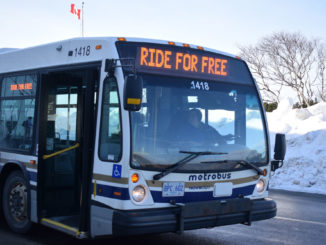Public transport in Newfoundland is continuously gaining popularity but needs the means to accommodate a huge influx of passengers.
Kathleen Reddy
Kicker

Ridership for public transport is rapidly increasing in the St. John’s metro region, but the number of buses and drivers is not rising at the same rate.
Judy Powell, Metrobus’s general manager, says she believes there are a number of factors that have led to this surge in ridership, which is making planning difficult.
Metrobus has seen its ridership increase significantly since 2019. In that year, Metrobus handled almost 3.3 million rides; by last year, that number had increased to more than 4.7 million – a 45.2 per cent in that five-year period.
Following a downturn in rides in 2020 and 2021, the largest annual increase occurred between 2021 and 2022, when the ridership shot up to more than 3.5 million from just over 2.2 million – a whopping year-to-year percentage increase of about 56.3 per cent. It’s likely the end of COVID-19 lockdowns contributed to that year’s increase.
Powell says Metrobus certainly thinks the increase has something to do with rising immigration, inflation, gas prices, interest rates and vehicle insurance rates.
Metrobus also has a partnership with the province on a free bus program for those receiving income support, so those with access to free transportation are more likely to make the most out of it.
“It’s a wonderful problem to have,” Powell said, “but certainly you need time to respond to that.”
There have even been some occasions when drivers have had to leave riders at stops because their buses were full, even with every bus driver on the road.
The operation staff and drivers try to be quick to tweak things in order to take everyone on board, whether it’s to move a bus, change the time it travels or add something extra onto its route in order to help out another route.
One driver, who has been working with Metrobus for 10 years, says he welcomes the increase, as long as Metrobus find ways to accommodate it. (Kicker has agreed not to identify the driver because of city restrictions about who can speak with the media.)
Right now, he’s willing to take on a full standing load to the point where riders can barely move in order to get everyone where they need to go during this upswing.
The driver says he thinks it’s up to the city to accommodate all of these people. He also says he understands the struggles with budgets and money, but when there are issues happening on the bus because of it, then it’s time to investigate.
Powell says Metrobus has hired the firm MQO Research to conduct customer surveys, a jurisdictional review as to what’s happening in other areas and a review of immigration policies to see what the service can expect in the next three- to five-year period.
Once all of this information is gathered, Metrobus will be in a position to put together a new growth plan for the province and obtain funding in order to get more buses on the roads and hire more staff.
“I think everyone recognizes that in order for everybody to be accommodated, buses might have to be a bit crowded, but at least we can fit everybody,” Powell said, “because it could be you that’s left behind tomorrow or the next day, so I think people are pretty understanding.”




Be the first to comment